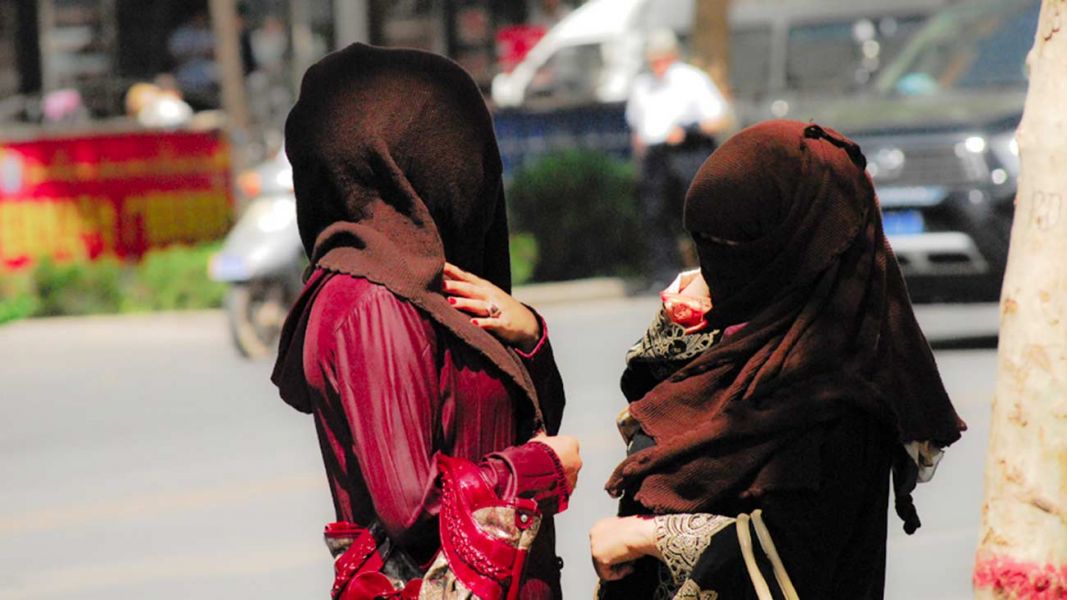
Global Connections: Chinese Feminism, Tibet, and Xinjiang
Chinese feminists are good at making global connections. From showing solidarity with the Stanford Survivor (Phillips 2016), to Zheng Churan’s public letter to Trump on ‘straight man cancer’ (BBC 2016), to supporting the Irish movement for abortion rights (Li 2017), feminists in China have worked hard to reach out, identify shared experiences of oppression, and forge alliances with feminists around the world. More recently, China’s #MeToo campaign showed feminists locating their own struggle within an international discourse and joining the international fight against sexual harassment. While the last few years have seen increasing government crackdown on discussions of feminism and civil society more broadly, a commitment to ‘walking with women from all over the world’ (和全世界的女人一起散步) remains (Feng 2017).
The activists behind China’s ‘New Feminist Movement’ (新女权运动) are largely young, urban-based, middle-class, and university-educated women, a number of whom have studied abroad. They are social media savvy and imaginative in bringing campaigns for gender equality to a broader audience. Alongside transnational exchange and a resistance to being anchored in state feminism’s conception of women’s rights, this movement is also characterised by an explicit concern for intersectionality.
Intersectionality provides a framework for understanding the ways in which various structures of power converge to produce systems of interlocking oppression and privilege (Crenshaw 1989). By focussing on the experiences of Black women, Crenshaw argued that a single-axis analysis of either feminist theory or anti-racist politics tends to distort and even erase the complexity of their experiences. In contrast, taking an intersectional approach allows us to think through the ways in which power works across different institutions and social categories, such as gender, sexuality, race and ethnicity, class, nationality, ability/disability, faith (or lack thereof), and so on.
In China, gender and class constitute one example of how feminists have engaged with intersectional analysis. Organising around class and developing critiques of exploitation under global capitalism is officially frowned upon in post-socialist China, but that has not prevented the online platform Pepper Tribe (尖椒部落) from doing so. The website bears the slogan ‘we don’t sell pepper, but we make female workers scream louder for their rights’ and features stories from female workers across China where they describe their life in the city, work, and experiences of sexual harassment (Tang and Huang 2018). Before being ‘harmonised’ in July 2018 for ‘violating relevant regulations’, it had over 20,000 followers on Weibo, and to this day it continues to maintain an active account on WeChat. Feminists in different parts of the country have also held workshops with female migrant workers to discuss various issues about their work experiences, advising them on how to access social services and build support networks. A Beijing-based feminist quartet named Jiu Ye has even been travelling the country performing songs written hand-in-hand with female migrant labourers (Yin 2017). All these examples demonstrate a shift away from thinking about power and oppression in single-issue terms.
Intersectionality has been more explicitly applied elsewhere. Feminist Voices (女权之声), one of the most influential online feminist platforms in China, was particularly vocal in problematising notions of universal experiences of womanhood. They often posted essays on the ways in which gender and sexuality intersect, particularly for queer women, and what this means for marriage and having children, as well as critiques of family life more broadly. Gender was also sometimes discussed in terms of class, disability, age, and hukou status. Sadly, Feminist Voices was deleted from both Weibo and WeChat around International Women’s Day in 2018 for violating ‘temporary regulations on the development and management of accounts offering public information service on instant messaging programs’ (Feng 2018).
Across these various discussions, attention to the convergence of different forms of power and oppression, and the importance of global connections are clearly evident in Chinese feminist practice. However, considerably less visible has been the issue of how gender and ethnicity intersect.
Gender and Ethnicity in Tibet and Xinjiang
China has 56 officially recognised minzu (民族), loosely translated as ‘nationalities’ or ‘ethnic groups’. The Han, making up more than 90 percent of the overall population, dominate politically and culturally. They are regularly depicted as the ‘big brother’, selflessly ‘bringing modernity’ to ‘ethnic minorities’ (少数民族) such as the Tibetans and Uyghurs. Han superiority is a long-standing narrative reproduced across official propaganda, popular media, and even in educational materials, with the aim of naturalising and legitimising Han hegemony across the country. Indeed, the very language of minzu itself plays into this process of flattening disputes about Tibet and Xinjiang’s place within China’s national and historical imagination into a question of ethnicity (Lokyitsang, 2012).
Though differing in many important ways, Tibet and Xinjiang are broadly similar in their colonial and contested status within the People’s Republic of China (PRC), international profile, strong religious and cultural practices, and strategic value as borderland regions. All of these factors mark them out as points of particular sensitivity for the Chinese authorities. Since the early 2000s, the Party-state has attempted to resolve ongoing issues of ethnic unrest and marginalisation across the regions through a whole range of economic development policies. While this shift has created opportunities for some, it has also led to more inward migration, greater competition for employment, economic disparity, and environmental degradation, all of which have fuelled further ethnic discontent, alienation, and resentment. Particularly in the case of Xinjiang, these new policies coincided with the state’s adoption of the discourse of ‘Global War of Terror’ and the recasting of Uyghurs as a ‘terrorist threat’ in 2001 (Roberts 2017). Since the Tibet protests in the spring of 2008 and the Urumqi riots of the summer of 2009, and coupled with an ‘ideological turn’ within the Chinese Communist Party emphasising the consolidation of overall political security (Smith Finley 2018), both regions have experienced even greater cultural and religious repression, pressure to assimilate, heightened state security, and widespread and arbitrary detention of people from all walks of life.
As in many Western countries, the Internet in China has also had a decisive role to play in fuelling a politics of fear and facilitating the rise of Islamophobia. While Han supremacism, nationalism, and racism are certainly not new across online spaces in China (Leibold 2010), theses discourses have become increasingly informed by the global circulation of extremist rhetoric. Similar to the ideologies and vocabulary emanating from right-wing populism in Europe and North America, discourses of ‘Islamisation’ have gained momentum across Chinese social media as a critique of what they perceive to be the excessive ‘political correctness’ of Western liberals. Echoing anti-immigrant, anti-refugee, and White nationalist discourses in the West, Muslims across China have become identified as an existential threat to the Chinese nation (Zhang 2017). Feminism and LGBTQ+ rights are also targeted as part of these discourses, further silencing dissent and consolidating the legitimacy of the Party-state.
Under these current conditions, most criticism of the various forms of discrimination against ‘ethnic minorities’ across China face in their everyday lives is generally swiftly silenced. Even in those rare moments when critical Tibetan and Uyghur voices are not immediately erased by censors or attacked by extremists, they are sure to be overwhelmed by calls to maintain ‘ethnic harmony’ and ‘ethnic unity’, obsessive deflections referring to Western hypocrisy and conspiracies to divide China, and denials that any problem exists at all.
For Tibetan and Uyghur women, living under a state that is both Han-centric and patriarchal entails a double burden, and their bodies have often become an important locus in the state’s push for social regulation and control. One example of this includes the launch of ‘Project Beauty’ (靓丽工程), a five-year campaign encouraging Uyghur women to remove their veils in an effort to look ‘modern’. Since then, we have seen various iterations of this campaign punishing Uyghur women for looking ‘too Islamic’. On World Hijab Day in February 2015, a full ban on the veil in public places was enforced across Urumqi. Similar draconian regulations were later rolled out for men with ‘abnormally’ long beards (Grose and Leibold 2015).
Experiences of gender and ethnicity overlap in complex and often brutal ways, and it is important to think about the structures of power that produce this, as well as the kind of work that is necessary to dismantle them. Indeed, gender injustice is always part and parcel of broader forms of injustice. Across Tibet and Xinjiang, heavy police presence, surveillance, travel restrictions, and detention have become everyday realities over the past decade. In response, since 2009 there have been over 150 cases of self-immolation in Tibet. This has taken an enormous toll on Tibetan society, marked through, as Tashi Rabgey recently described, a collective ‘silent mourning’ (SupChina 2019). Much of this happened under the intense securitisation and policing strategies of Chen Quanguo, the Party Secretary in the Tibetan Autonomous Region between 2011 and 2016. In August 2016, Chen took up the same role for Xinjiang and since his arrival the situation across the region has deteriorated significantly (Smith Finley 2018). The mass internment of approximately one and a half million Uyghurs in ‘reeducation’ camps as part of the Party-state’s efforts in ‘deextremification’ has left few lives untouched. Camp survivor Mihrigul Tursun has described her own experiences of internment, during which time one of her young triplets died under mysterious circumstances while the other two developed health problems (Cockburn 2018). She has detailed how women were forced to take pills that made them faint, and to drink a white liquid that caused bleeding in some women and loss of menstruation in others. Her account mirrors those of Gulbahar Jelil, another Uyghur woman who has described her experiences of being forced to share a 14-square-meter space with 30 other woman and restricted to a starvation diet of 600 calories a day (Byler 2018). Forced marriages between Uyghur women and Han men, state intrusion into private homes through surveillance by civilian Han ‘relatives’, disappearances of entire families, separation of children from parents, and reports of torture and death within the camps all reflect the ongoing horror and trauma of everyday state violence in Xinjiang today (Beydoun 2018).
Disconnection in the Chinese Feminist Movement?
In my conversations with Han feminist activist friends over the years, I have learned that the ways in which gender and ethnicity intersect are rarely, if ever, discussed as a feminist issue within their own circles.
Given the heavy censorship in media coverage about life in Tibet and Xinjiang, and the steady stream of propaganda celebrating state subsidies and preferential policies enabling ethnic minorities to ‘reach modernity’, it is perhaps not surprising that Tibet and Xinjiang have become a blind spot in intersectional practices among Han feminists. Indeed, Chinese state media regularly celebrates the state’s ‘liberation’ of Tibetan and Uyghur women. Last year, for example, the Global Times reported that, under the careful guidance of the state, Uyghur women had gained ‘respect and self-recognition’, while Uyghur men had learned how to ‘respect women and admire their contributions to the family’ (Li 2019). In Tibet, stories of women achieving ‘empowerment’ through the state’s various social, economic and ecological policies are another regular feature in state media (Global Times 2019b). These examples demonstrate how the Chinese state regularly tries to repackage its ongoing violence against both Tibetan and Uyghur societies as a project of social progress. As such, the silence within Han Chinese feminist groups surrounding the specific issues faced by Tibetan and Uyghur women, as well as Tibet and Xinjiang more broadly, in many ways reflects the wider culture of state propaganda, censorship and Han normativity that pervades Chinese officialdom, education, and media.
There are, however, some Han feminists who are thinking about the place (or lack thereof) of minzu politics within China’s feminist movement. Should Tibetan and Uyghur feminists and women’s rights activists be incorporated under the banner of ‘Chinese feminism’? Who gets to decide that? I have also heard a few Han feminists ask how such a cross-cultural feminist solidarity across the PRC could be crafted without reinforcing the hegemony of Han ‘Chineseness’.
While these are important questions that demand conversation across different minzu groups, the gravity of the situation in Tibet and Xinjiang also requires urgent action. But building feminist solidarity and coalitions is far from simple. Amidst the ever-intensifying crackdowns across the country in the name of stability, security, and unity, there is a level of fear that can be difficult to fully comprehend for those of us who are not Chinese citizens. Many Han feminists are all too aware of the risks involved in speaking out against state violence. Since 2015, they themselves have faced surveillance, intimidation, and even detention for simply speaking out against sexual harassment on public transport, and know very well what criticising the Party-state’s actions in Tibet and Xinjiang invariably lead to.
The (Im)possibility of Resistance?
While many might hope that something akin to the #MeTooUyghur movement on Twitter and Facebook would also grace WeChat and Weibo timelines, such a thing is simply impossible to imagine right now. Although there are some who are speaking up—and whose messages are promptly ‘harmonised’ by censors—to conceive of a broader movement, there would need to be so much groundwork done to reverse the decades of endless scaremongering, distortion, and wilful erasure of Tibetan and Uyghur dissent. There would need to be so much done to change the terms of public debate about ‘ethnic relations’ in China, and to challenge the dehumanising discourses that have enabled the pervasive violence against Tibetans and Uyghurs. But currently, the greatest obstacle to any possibility in this sense is that any form of public opposition to what is happening in either Tibet or Xinjiang has become extremely dangerous for anyone in China.
The impossibility of speaking out in China makes it all the more important for those of us outside of China to do so. The support of Chinese citizens abroad is crucial. Despite being afraid and knowing the risks, some of them are already speaking out on social media. Others are educating themselves by going to public talks on what is happening in Xinjiang, asking what they can do to help, and challenging the views of their own friends and family members. Moreover, recently, the Independent Federation of Chinese Students and Scholars, a US-based network founded in response to Tiananmen Square protests of 1989, condemned the actions of Chinese students who harassed, abused, and threatened Uyghur and Tibetan students at Duke, University of Toronto, University College Dublin, University of Strasbourg, and elsewhere, criticising all efforts to ‘suppress the truth about the ongoing genocidal crimes’ (RFA 2019).
Non-Chinese citizens can also do a lot. We should remember how influential the international response to the detention of the Feminist Five was in determining their eventual release. Indeed, we have already seen the impact of global pressure in the case of Xinjiang. The diffusion of media reports and satellite images of the ‘reeducation’ camps have forced the Party-state to shift from a position of totally denying the very existence of the camps to trying to justify them. To continue the fight, we must contact our government officials, our embassies and consulates in China, and our local Chinese embassies to firmly express our opposition and call for an immediate halt to the arbitrary detention of Uyghurs. We must contact the long list of companies who continue to do business in Xinjiang and ask them why they do so, knowing full well the widespread injustice and suffering across the region (China File 2018). We must join the #MeTooUyghur campaign, donate to the Uyghur Human Rights Project (UHRP), organise public talks, and start campaigns at our schools and universities to show solidarity with Uyghurs and to increase public awareness about what is happening in Xinjiang today (see UHRP for more).
These are all small but vital steps we can take to keep the pressure on and stop the violence against Tibetans and Uyghurs, but everyone must also challenge Islamophobia, racism, state authoritarianism, the securitisation of borders, the rise of private security firms, and the prison industrial complex within our own communities. We must insist, as Angela Davis (2011) has long argued, on seeing the intersections and interconnectedness of ‘local’ practices of injustice and what is happening across Xinjiang and Tibet. Without this, there will be no getting to the root of what is in many ways a global problem. Many recognise the intensification of Chinese state patriarchy as part of a growing nationalist strongman politics around the world, but we must also recognise how the same politics, alongside transnational online right-wing extremism and carceral capitalism (see Roche’s op-ed in this issue), are fuelling state terror across China. We must also see the struggle for liberation in Xinjiang and Tibet as part of the struggle for liberation everywhere.





